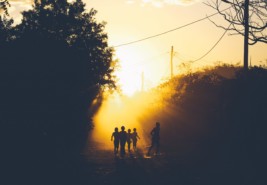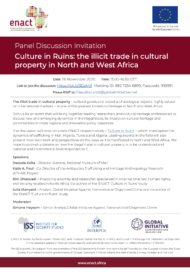Posted on 18 Oct 2017
Locally manufactured weapons are inexpensive and increasingly used across West Africa.
The trafficking and illicit circulation of small arms and light weapons (SALW) is often discussed in the context of fuelling instability and insecurity in West Africa. Rarely, however, do these conversations give appropriate attention to the issue of locally manufactured weapons.
The production of firearms by local artisans is not new to the region. It has existed in many countries (e.g. Benin, Burkina Faso, Côte d’Ivoire, Guinea, Liberia, Mali, Nigeria, Senegal, Sierra Leone and Togo) for decades, and in Ghana’s case, for centuries.
Over time, local manufacturers’ knowledge has improved and the level of activity seems to have increased.
Firearm production and the dynamics that shape it vary considerably from one country to another. It is therefore necessary to avoid generalisation. The few available empirical studies that exist provide a glimpse into some countries – for example, Ghana, Côte d’Ivoire, Benin, Togo and Nigeria. These describe an artisanal, informal and mainly clandestine industry, animated by blacksmiths whose knowledge is passed on to the next generation and apprentices.
The homemade weapons found in West Africa are typically rudimentary duplicates of existing firearms. They include pistols, shotguns (e.g. single-barrel, double-barrel and automatic rifles) and ammunitions. In countries such as Ghana, blacksmiths are even able to reproduce – at least in appearance – assault weapons, such as the AKM, a version of the well-known AK-47.
Manufacture is mainly demand driven, with hunters as the main clients. There is, however, a lack of transparency and control of weapons sales in the region and some arms end up in the hands of criminals. The demand can be local, national or regional (such as when arms are smuggled into neighbouring countries).
Not all blacksmiths possess the skills to engage in full-scale gun production; most of them appear to be only involved in repairing and assembling firearms. Arms are repaired or manufactured using different kinds of metal, which is recovered from used tools that are melted, recycled and repurposed.
Gunsmithing only represents one facet – certainly the most profitable – of blacksmiths’ activity. Blacksmiths also manufacture items such as kitchen utensils and farming tools and hide the production of firearms behind this legal trade and income stream.
Homemade firearms – even more than imported firearms – fuel banditry, organised crime, inter-communal conflicts and clan and political rivalries. These arms are also relatively inexpensive (between US$15 to US$120 in Ghana and US$90 to US$150 in Côte d’Ivoire, depending on the type of firearm and level of technicality). While these weapons are not sophisticated, they are dangerous.
A clear example was seen in Nigeria in August, when the police arrested a group of people in the northern state of Kaduna in connection with kidnapping for ransom. The weapons recovered from the incident reportedly included three AK-47s and 10 locally-made sub-machine guns. Over the past few months, kidnapping has taken on a dangerous dimension in several parts of Nigeria.
In 2015, at a forum hosted in the south-eastern part of Nigeria by the Presidential Committee on Small Arms and Light Weapons, it was revealed that nearly 60% of the illegal arms circulating there were locally produced.
In Ghana, almost 90% of firearms used in armed robbery are reportedly locally manufactured. In Benin, a member of the National Commission against Small Arms recently stated that the majority of robberies on roads and in urban areas had been carried out with locally manufactured weapons. Similarly in Mali, according to a report released in 2010, some 80% of armed robbery and acts of banditry in urban areas were perpetrated with locally manufactured firearms.
It is estimated that in Ghana, local gunsmiths have the capacity to produce over 200 000 weapons annually. In Mali, 2010 data established that the annual production was close to 5 000 weapons.
These figures are likely to be low estimates, as they are not based on an exhaustive inventory of gunsmiths. Nonetheless, they provide insight into the scale of the problem and its impact on security.
Locally produced arms are less controlled and therefore more easily trafficked. This further encourages illicit circulation throughout West Africa, especially in border areas. Along borders, it appears that there are implicit links between the local manufacture of firearms and other criminal or illegal activities, such as drug trafficking and illicit exploitation of precious minerals. These links need to be further explored.
In acknowledgement of the issue, countries such as Burkina Faso, Ghana, Mali and Sierra Leone have begun to work with with local manufacturers to better control their activities. This has been done mainly through a census of weapons producers and the creation of associations to bring together local manufacturers. These measures are in line with the provisions of Articles 7, 8 and 12 of the Convention of the Economic Community of West African States (ECOWAS), which provides measures to control the manufacturing of SALW and to initiate dialogue with local manufacturers.
Despite some progress, the results remain mixed.
Across the region, there are manufacturers who are unwilling to participate in these efforts and who continue to evade regulation. The industry is often illicit and continues to evolve, which makes collecting up-to-date and accurate information a serious challenge.
Efforts to identify, register and regulate gunsmiths should therefore be initiated and enhanced throughout the region. While the legal and regulatory mechanisms to do so exist in most countries in the region, implementation remains weak.
To limit the manufacture of firearms, several countries have offered job training and alternative livelihoods to local gunsmiths. But gunsmithing is lucrative and such programmes have not been very successful. Tougher approaches are needed to decrease local firearm manufacturing. If African leaders are serious about silencing the guns by 2020, it is crucial that they take a closer look at locally manufactured weapons.



